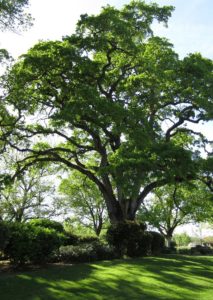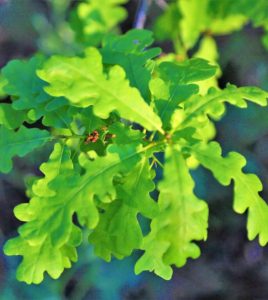Some links in the post are affiliate links and I get a commission from purchases made through some links found in the post.
Oaks are mighty and magnificent trees and their beauty captivates us to this very day.
They are an essential part of the forest ecosystem as they produce extensive shady canopies for wildlife.
Even around urban landscapes, they add tremendously to the beauty and show a wonderful array of seasonal color changes.
They are very sensitive to their environment once they mature and don’t tolerate a change in their existing conditions.
To fertilize an oak tree is not a big challenge. You just need to know the proper way to channel the nutrients to prevent the weak growth.
Best Fertilizer for Oak Tree
Oaks are hardy plants but this doesn’t rule out their fertilizer requirements. Mature and well-established oaks need very little fertilizing.
The leaves that are shed from the tree saturate the soil with nutrients and replenish the minerals over again.
Organic fertilizers should be the priority as they are well rounded and balanced in providing nutrients. Manure and compost are the be
Inorganic fertilizers can also be used for oaks but they have to be in a specific ratio. Over-saturating the oak with nitrogenous fertilizers causes unwarranted and structurally weak growth.
The branches come out as weak and flimsy and they are prone to splits and breakage. So fertilizers like NPK should be employed.
The term NPK represents the specific amounts of Nitrogen, Phosphorous and Potassium included in the mix.
The ideal ratio of these nutrients for oak trees should be 12-6-6 or 12-4-8. These fertilizers release nitrogen very slowly and prevent the deleterious effects of over-fertilization.
Both liquid or granular forms of fertilizer can be used. If this kind of supplemental feed is adopted, then at least 2 pounds of nitrogen should be supplied per 1000 square feet of bed area covered.
How Often Should You Fertilize Your Oak Tree
Oaks need should be fertilized twice a year. Once in early spring and once during fall. Nonetheless, spring is the best time to fertilize your oak tree.
The growth potential is greatest in June and July, and to reap full benefits, the oaks should be fertilized during these months.
Trees older than 10 years rarely require fertilizer. Most of them can fare well even without the use of fertilizer as the shed leaves are enough for their nutrient replenishment.
If you are enjoying this article, check out our article on what are the fastest growing evergreen trees for small gardens.
How to Fertilize a Pin Oak Tree?
 Pin Oak is a fast-growing shady tree that grows best in rich and well-drained soils.
Pin Oak is a fast-growing shady tree that grows best in rich and well-drained soils.
The tree is prized for its attractive pyramidal appearance and brilliant display of red autumn leaves. The tree grows best in the soil of pH ranging from 5 to 6.5.
The most common problem faced by pin oaks is iron chlorosis which occurs when the soil becomes alkaline.
The leaves become yellow and fall off prematurely giving the tree an unsightly appearance. Iron is necessary for the production of chlorophyll which gives the leaves the green color.
The high pH restricts the plant to extract iron from the soil and this causes deficiency in the plant. Other things that might precipitate this condition include:
- High soil moisture;
- Large amounts of trace minerals like copper, zinc, or manganese
- Inadvertent application of phosphorus.
Methods to Treat Iron Chlorosis:
1) Correcting the Soil:
The pH of the soil should be lowered by the use of organic fertilizers like peat moss and compost.
After balancing the pH, the soil is enriched with iron by application of sulfur and iron.
The treatment steps involve drilling holes around the tree about 1 foot in depth and filling the holes with iron sulfate.
The iron now becomes easily accessible to the roots and the tree can recover from this condition.
2) Foliar Spray of Iron Chelates:
This is a short-term solution to a long-term problem. Iron sulfate or iron chelates are dissolved in water and sprayed on the leaves.
The iron stores of the leaves become quickly restored but the iron doesn’t enter the whole system of the tree. For that, treating the soil is essential.
3) Injection Therapy:
This remedy is the last resort as it has a variable degree of success. In this technique, iron citrate or iron sulfates are impregnated 1-inch-deep in the tree trunk.
After that, the hole is sealed using grafting wax. Injection therapy has a chance of failure and can even cause harm to the tree.
The best time to use this mode of therapy is early spring.
Fertilizing Post Oak Trees:
Post oak tree (Quercus stellate) is a species of white oak native to North America. It is commonly found in the states of Texas and Iowa.
It is relatively slow-growing as compared to other species but fares well in the toughest of soil conditions.
Since post oak trees grow slowly, they are quite vulnerable to instant changes in their environment.
They are very averse to the urban activities around them.
The roots system of these trees is fairly shallow and they get most of their nutrients from the topsoil. They need a well-drained neutral soil for their growth
In terms of fertilizers, these trees abhor high nitrogenous types. The application of such types of fertilizers stimulates extra growth.
This process is already contrary to their slow-growing nature. The reserves of the tree are used in unnecessary growth spurt which makes it weak.
Organic fertilizers should be used as a priority as they don’t cause drastic changes in the pH and nutrient balance of the soil.
Timely application of manure and well-decomposed compost is essential for their proper growth.
They also do well with inorganic fertilizers like NPK 15-5-10.
The amount that should be administered is roughly 5 pounds per 1000 square feet of the bedding area.
The ideal time for fertilization is in early spring. The reapplication can be done after 6 weeks as long as new growing shoots are visible.
Special precautions should be taken to prevent over-fertilization of the trees as it could lead to their early death.
How to Fertilize Oak Saplings?
Oak trees are not that hard to grow. For the saplings, the greatest amount of inorganic fertilizers should be applied during early spring and the start of fall.
Young oak trees with ages ranging from 3 to 5 years need fertilizer application twice a year. As these trees mature the amount of fertilizer is increased gradually up to 10 years.
The amount is increased by 0.05 pounds per year after the age of 3. When the tree has reached its 4th year of growth, the ideal time of fertilization should be in the fall.
You may also like: how do you save an overwatered palm tree
Should Old Oak Trees Be Fertilized?
 After 10 years the oak trees can survive easily without any external help. The leaves that shed each fall are a big source of recyclable nutrients for the tree and the ecosystem.
After 10 years the oak trees can survive easily without any external help. The leaves that shed each fall are a big source of recyclable nutrients for the tree and the ecosystem.
They should be left on the ground to decompose and not be picked up as soon they fall. The trees should be left as close to their natural state as they are in the forests.
They like to be covered by several layers of fallen leaves and rich leaf compost. If the trees seem dull, high-nitrogen fertilizers can be employed to rejuvenate them once again.
Very mature trees .i.e. older than 20 years do not need any fertilizer at all.
They have a well-established root system that enables them to get all the required nutrients from the environment with ease.
Common Mistakes When Fertilizing Oak Trees
A lot could go wrong if you use improper techniques to fertilizer your oaks.
As already mentioned, they are quite shy of changes in their soil and prefer a balanced approach.
Following mistakes should be avoided at all costs to prevent any harm to these magnificent trees:
1) Overfertilization:
As most species mature slowly, oaks aren’t that needy in terms of fertilizer. Oversupply of nutrients can cause weak growth and structural instability.
2) Poor Fertilizer Choice:
The use of organic materials should be a priority. Other than that, balanced NPK fertilizers should be used. Saturation of one type of nutrient results in limited availability of other types in the soil.
3) Improper Timing:
The full benefits of fertilizers are reaped when they are applied in seasons of growth like early spring and fall in the case of oaks.
Applying outside this period results in decreased effectiveness of the application. This renders the effort futile.
4) Neglecting Trace Minerals:
Even though NPK are required by oaks in a greater amount, trace elements like zinc, magnesium, and calcium are also needed for proper growth.
They are needed in adequate amounts for chlorophyll production which makes the trees look fresh and healthy.
If you enjoyed this article, check out how to care for a naga linga tree in your house.
Final Thoughts: How to Fertilize Your Oak Tree?
 Oak trees are not a big hassle when it comes to their care. They are hardy and can live for many years.
Oak trees are not a big hassle when it comes to their care. They are hardy and can live for many years.
The only reason that they come under stress is due to the sudden change in their environment.
For that reason, the fertilizer application and all the associated care should be given gradually.
Rapid corrective measures may solve the problem for the time being but it may pose a bigger risk for the health of the tree afterward.
Other than that, following all the mentioned steps will ensure healthy oak trees in no time.
Before you go, here are some more related articles I encourage you to read below to help solve more of your gardening issues:
Where Should You Plant A Japanese Maple Tree
Top 5 Best Small Trees with Non Invasive Roots
What are the Best Trees to Plant Near Your House for Shade
About the Author:
Saad Ansar
Saad is an avid gardener himself and is a great lover of plants, animals, photography, & people. Currently, he is focused on photographing indoor plants & captioning beautiful outdoor sceneries. He writes and rewrites in-depth articles on nature and science.

